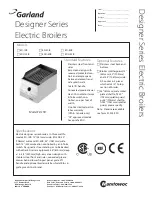
Supplied By www.heating spares.co Tel. 0161 620 6677
2
Linea Plus AG
SECTION 2
DESIGN PRINCIPLES AND OPERATING SEQUENCE
2.1
Fig.1 illustrates the general layout of compo-
nents. Fig.2 illustrates the operating principles
described below.
2.2
Central Heating Mode
2.2.1
When the various switches and controls im-
pose a demand for heat, the pump is started.
If the primary pressure is sufficient, the
electronic circuitry is energised. The fan is
started, the gas valve is energised at an inter-
mediate rate and the electronic ignition goes
through an ignition attempt.
2.2.2
The burner ignition is checked by the electronic
circuitry to ensure correct ignition of the burner;
once successful the gas will flow at 75% of
maximum heat input for a period of
approximately 15 minutes and then go to maxi-
mum heat input to maximise heating perform-
ance, unless the boiler nears optimum
temperature where it will modulate down to suit
system load.
2.2.3
As water temperature increases this is sensed
by the temperature sensor on the flow pipe
which modulates the fan and burner to match
the heat output to the heat requirement of the
system.
2.2.4
Depending on the load, either a) The water
temperature will continue to rise and the fan
and burner will continue to modulate down;
The burner will switch off at maximum tem-
perature, or b) the water temperature will fall;
the fan and burner
will return to a higher output to match de-
mand.
2.3
Domestic Hot Water Mode
2.3.1
The appliance incorporates a hot water
preheat facility. The appliance will therefore
ignite periodically to maintain heat within the
appliance.
2.3.2
The appliance will operate in domestic hot
water mode whenever the mode selector
switch is on regardless of mode selector
switch position and any demand for central
heating.
2.3.3
The diverter valve will automatically energise
into the hot water position after central heat-
ing demand, or will stay in the hot water
position after hot water demand. Opening a
draw off tap will energise the pump and fan
sending primary water to the domestic hot
water heat exchanger.
2.3.4
Temperature control is transferred to the do-
mestic hot water thermostat (potentiometer)
which modulates the fan and burner output
between high and low flame to maintain an
average heat input to suit the dhw output
required.
2.3.5
An overrun is incorporated in the boiler in both
c/h & dhw modes. The fan overruns until the
boiler water cools to approximately 80
°
C
(176
°
F).
2.4
Safety Devices
2.4.1
In both central heating and hot water modes
safe operating is ensured by:
A. Differential pressure unit in the primary
circuit which prevents burner operation if water
pressure is too low.
B. An electronic device that checks the pri-
mary pressure unit for activation. Failure re-
sults in deactivation of the pump, after ap-
proximately 10 minutes of operation.
C. A safety thermostat, which interrupts the
control circuit shutting off the gas valve. At the
same time the fan will still operate.
D. A DAPS in the flue system to check the
fan's operation before allowing ignition.
2.4.2
A safety valve is provided to relieve excess
pressure from the primary circuit.
2.4.3
Frost Thermostat
The appliance has a built in frost protection
circuit. Should the boiler temperature sensed
at the primary thermistor fall below 5
°
C, the
boiler will operate in central heating mode and
continue to operate until the primary thermistor
reaches approximately 40
°
C.
KEY:
A
Central Heating Return.
B
Central Heating Flow.
C
Hot Water Outlet.
D
Cold Water Inlet.
Flue Outlet
Air Intake
Fig. 2
NOTE
3
7
10
12
13
6
17
18
16
19
A
NOTE: Pressure switch.
Senses water pressure in the primary circuit
and operates the pressure switch (15)
15
B
C
D





































